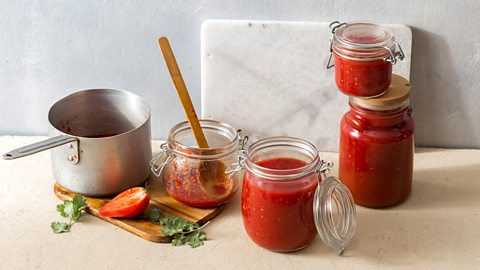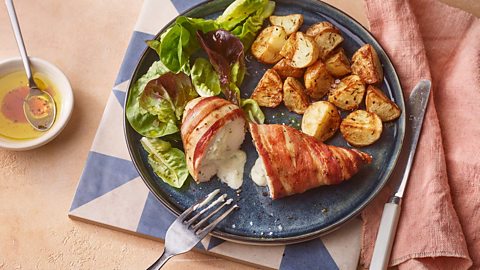Everyday ‘flavour bombs’ to liven up your food
Give lacklustre dishes impressive punch with these budget-friendly ingredients and hacks

Ever cooked a meal with high expectations only to find it tastes disappointingly flat? There are lots of reasons this can happen – think out-of-season ingredients, spices or herbs that have lost their punch and not having time to wait for the flavours to intensify during cooking.
Whether you're making bolognese, a roast dinner, macaroni cheese or anything in between, there are easy, affordable ways to dial up the flavour and make sure your meal packs an impressive punch.
Recently, we asked readers on Facebook and Instagram to spill the beans on the secret ingredients they use to add depth, zing or pow to their dishes. We're pleased to report that there were a lot of suggestions.
After sifting through them all, we collated the most popular and asked cookery experts for their tips on how and when to use each. So, get ready to say goodbye to drab dinners for good.
Anchovies and fish sauce

Izy Hossack, author of The Savvy Cook: Easy Food On A Budget, is a big fan of anchovies and fish sauce, and uses them in her cooking regularly.
“Both these ingredients are packed with savoury flavour and, contrary to what you might think, won't make things taste fishy. A word of warning, though: they are very salty, so add just a little bit at a time, and keep tasting.
“Anchovies are lovely for adding depth of flavour to tomato-based sauces like bolognese or chilli con carne. Try adding one or two finely chopped anchovies to a batch.
“Fish sauce is delicious in curries and fragrant soups – slosh in two to three teaspoons before you add salt, then top up with extra seasoning if needed.”
Yeast and meat extracts

Love or hate it, there's no denying that yeast extract (think Marmite) can do wonders for your food's flavour profile. Meanwhile, meat extract (Bovril, for instance) works in a similar way and is a great culinary trick to have up your sleeve, so long as you're not cooking for vegetarians or vegans.
“Even if you think you don't like yeast extract, its rich flavour can really enhance the meatiness of a recipe,” says Izy. “You can add a little – maybe one to two teaspoons – to things like onion gravy and meaty pie fillings to make them taste richer.
“I love using yeast extract in a veggie ragu to give it that beefy flavour without needing meat. I also think adding around half a teaspoon of either yeast or meat extract to a cheese sauce is a great way to enhance those salty, tangy flavours.”
Even roast spuds can benefit from a lick of these umami-laced ingredients, explains chef and restaurateur, Gemma Simmonite.
“Yeast extract is the reason my roasties have earned the moniker ‘best ever’ amongst my family and friends. Not a smear of duck fat in sight – just a salty slick of yeast extract rubbed over the potatoes before they go into the oven will give you the most flavoursome roasters ever.”
Balsamic vinegar

Although some varieties of balsamic can be expensive, if you shop around (look for supermarket own brands or try discount grocery shops), you can pick up a bottle for a reasonable price – and there's no doubt you'll get your money's worth from it.
“This is a go-to for me whenever I'm making a simple tomato sauce or something with Mediterranean flavours that needs a bit of a lift,” says Izy. “The balsamic brings sweetness as well as acidity which can often be something people miss out when trying to balance the seasoning of a sauce.”
“Usually, one to two tablespoons of balsamic is all you need to round out the flavour of something. Try drizzling it over roasted vegetables for the last 5–10 minutes in the oven – the vinegar will reduce down slightly to give you a sticky, sweet glaze.”
Related stories
Condiments

From mustard to ketchup, mayonnaise to ‘Hendos’ (Henderson's relish, if you're being proper), lots of different condiments were bigged up in our comments when we asked for everyone's favourite flavour bombs.
“Those bottles in your fridge aren't just for salad dressings or dips,” says Izy. “They're concentrated sources of easy flavour. Adding a little squeeze of ketchup or brown sauce into a stir-fry sauce brings a slight acidity and sweetness which plays out well with garlic and ginger.
“Horseradish or mustard are delicious additions for spreading thinly onto pastry in a tart before you add your toppings, and Henderson’s relish and Worcestershire sauce bring the umami factor to all kinds of rich stews.”

Gemma is a particular fan of tomato ketchup: “Ask any chef what their quick fix is, and they’ll begrudgingly admit it’s ketchup! I think most people know it’s the basis of any great barbecue sauce, but there are so many more ketchup hacks to discover. When a homemade marinara sauce or chilli is missing that sweet, rounded flavour, ketchup is key.
“It also makes an amazing sticky glaze for chicken or tofu when blended with soy sauce, honey, sesame oil, and five spice.”
Lemon and lime

While we all know the magic a squeeze of citrus juice works on white fish and salad dressings, there are plenty of other ways you can use lemon and lime to boost your food's flavour, says Izy.
“Both are great for adding to marinades for meat or tofu. Lemon zest works perfectly with Italian flavours, whilst lime is at home with Mexican or Southeast Asian dishes. You can try grating a little lemon zest over your pesto pasta for a bright hit of flavour. Or sprinkle a little lime zest and juice over your fajita fillings.”
Celery Salt

Those who use this flavoured seasoning swear by its versatility, it seems.
“Despite being a bit of a bland vegetable, celery’s seeds create one of the most umami-laden spices you can find,” Gemma says.
”I use these ground-up seeds – which you can buy mixed with salt – wherever an extra hit of savouriness is needed. For instance, when you’ve made a sauce but it’s not quite hitting the spot, celery salt will come to the rescue. I include it in so many of our mayo-based sauces at my restaurant too – it just makes them pop.
“It’s been mooted, and I have no doubt here, that it’s one of the eleven secret herbs and spices in a certain famous fried chicken recipe.”
Miso paste

The Japanese fermented soybean paste is frequently used for soup, but you can use it to up the umami in other dishes too.
“This is one of my favourite ingredients to use for an easy whack of flavour and I use it very similarly to yeast and meat extract a lot of the time,” says Izy.
“You can also mix a couple of tablespoons of miso with some honey, garlic, ginger and soy for a delicious glaze which works on everything from salmon fillets and chicken thighs to tofu and roasted carrots. Stir a heaped teaspoon of it into salad dressings to bring any simple greens to life, too.
“Just be aware that it’s quite salty and that there are different types (white, brown and red) which have different flavour profiles. Generally, the lighter the colour, the less intense the flavour. If you're new to miso, white miso is a good place to start as it has a sweeter, milder flavour.”
Pesto and sundried tomatoes

These two Mediterranean ingredients go hand-in-hand and are great for giving Italian-style dishes extra punch, Izy explains.
“If you're making a lasagne and you want to boost those rich flavours, a few chopped sun-dried tomatoes and a couple of heaped tablespoons of pesto are the answer.
“Pesto can also be used as a glaze of sorts for chicken and fish, or loosened with some olive oil to make an instant dressing that's great for pepping up steamed vegetables and soups (it's amazing on a minestrone). Sun-dried tomatoes can be chopped up and sprinkled into tomato-based pasta bakes to intensify the flavour or, you can blitz them into vegetable soups for a similar effect.”
Nutmeg and cinnamon

We all know these are great in puds, especially autumnal favourites such as crumbles and pumpkin pie but they are equally good in savoury dishes, explains Izy.
“I can't resist adding a small grating of nutmeg to white sauce or creamy gratin-based dishes like lasagne, potatoes dauphinoise and macaroni and cheese to add an extra dimension of flavour.
“It's also really lovely to add a little to the meat when you're making meatballs. Nutmeg has a strong flavour, so you only usually need a pinch or two in a pot of sauce. Also, if you buy whole nutmeg, it'll be a lot stronger than pre-ground, so you'll need less.
“Cinnamon is incredibly versatile as it works in so many different cuisines. It's lovely in many Mexican, Indian, Chinese, North African and Middle Eastern dishes. I like using it in spice mixes for chilli or enchiladas for its warming flavour, but it also works well in kofte or added to brothy braises like tagine.”
Originally published October 2022



